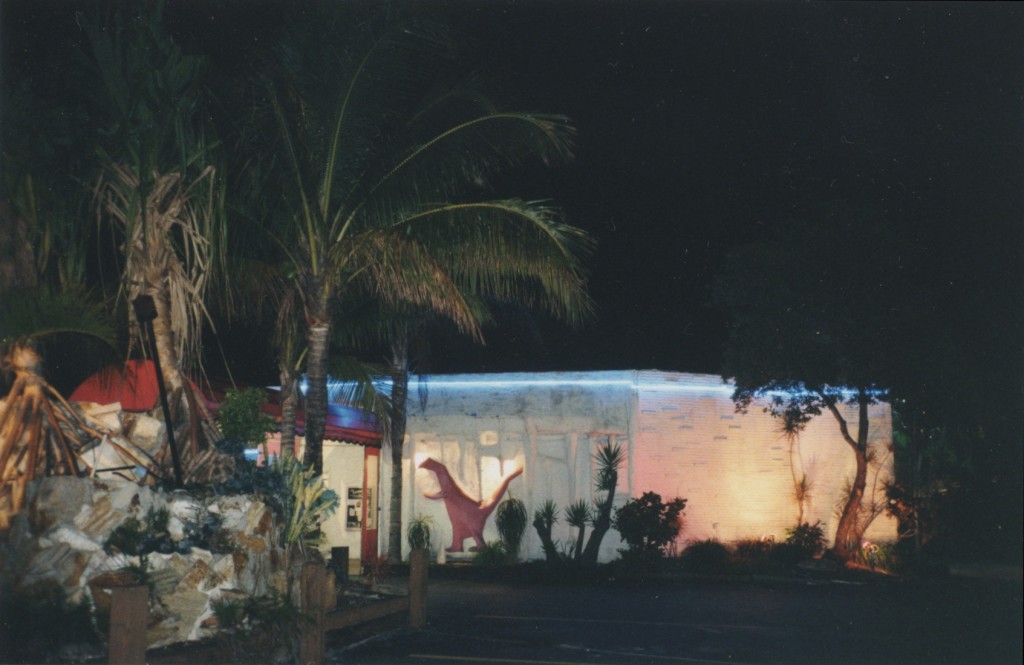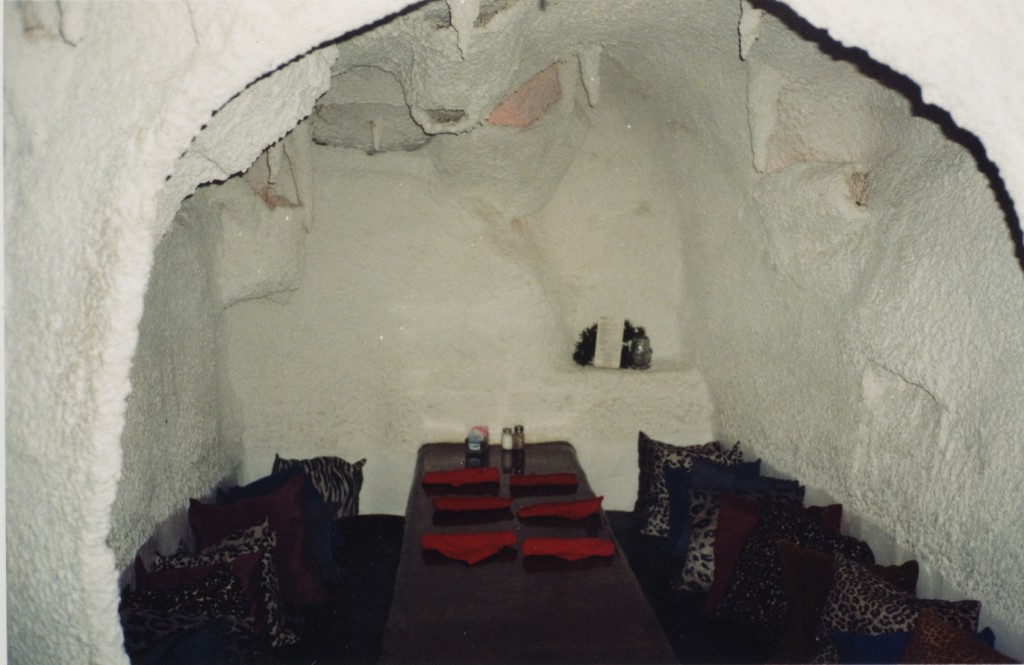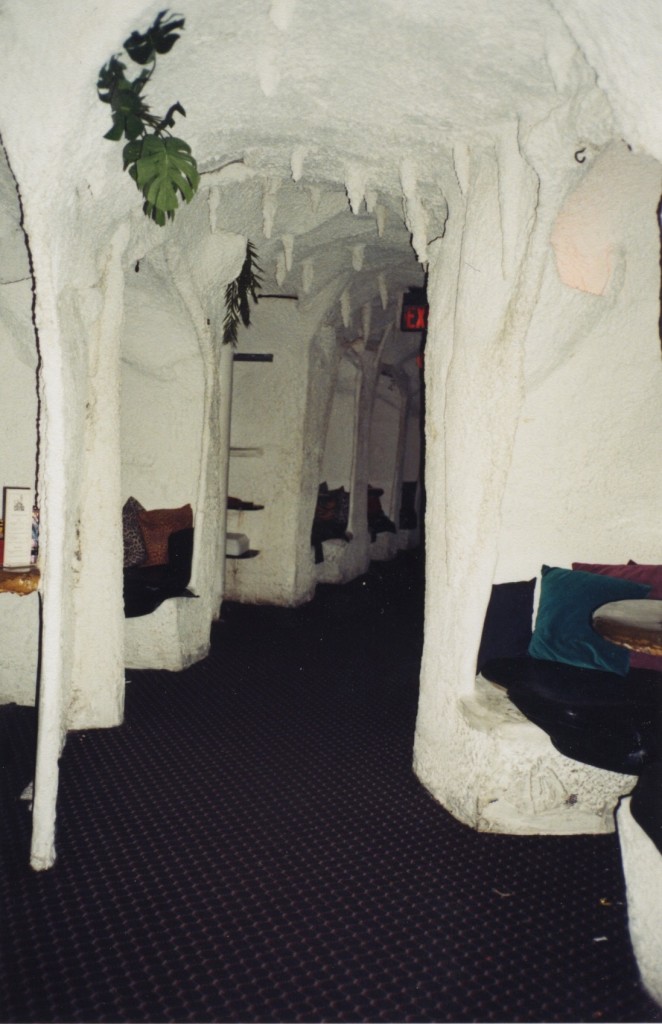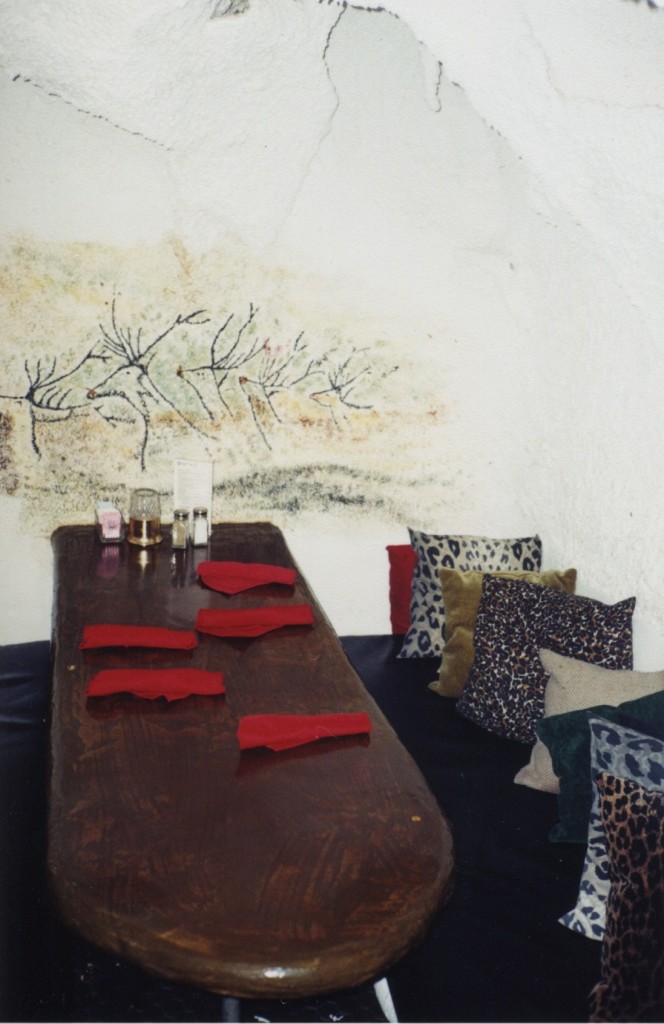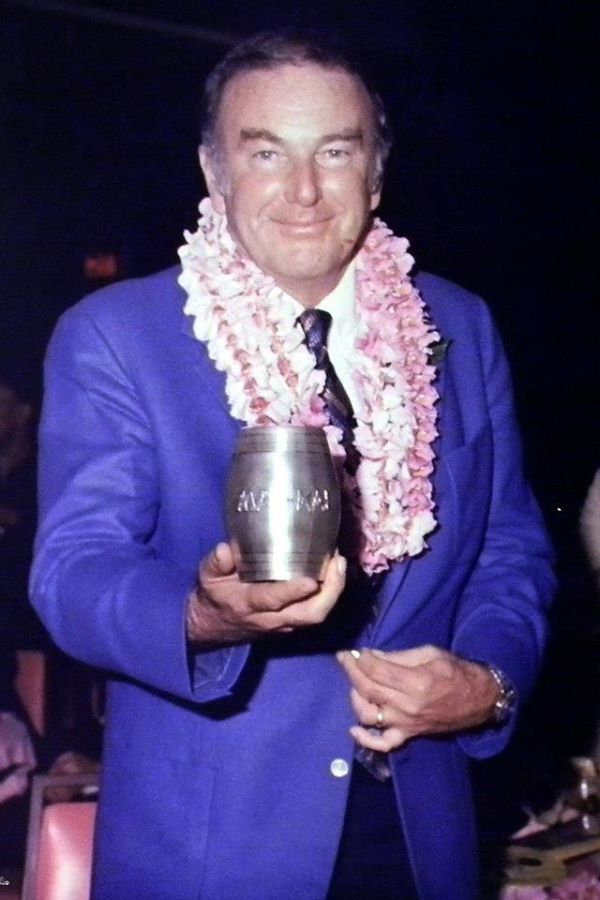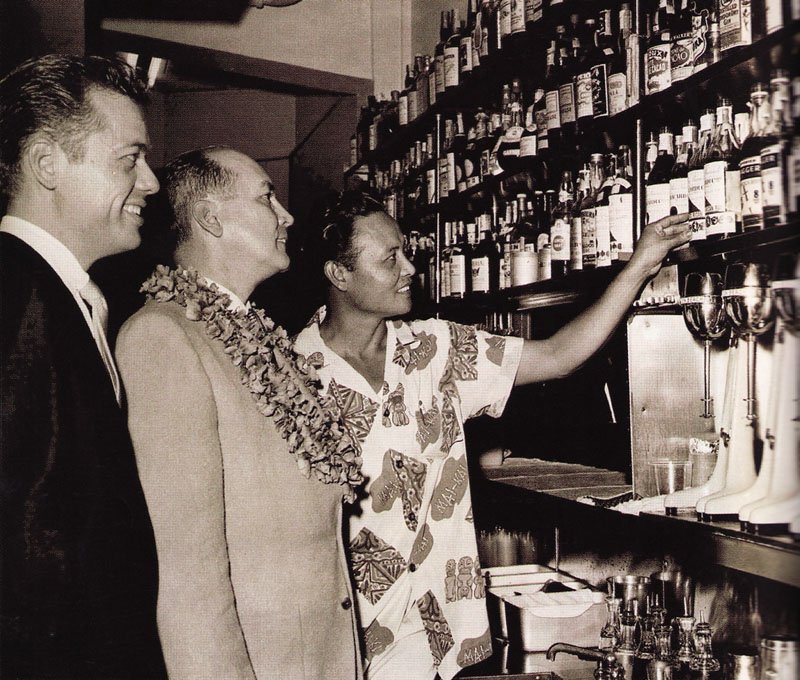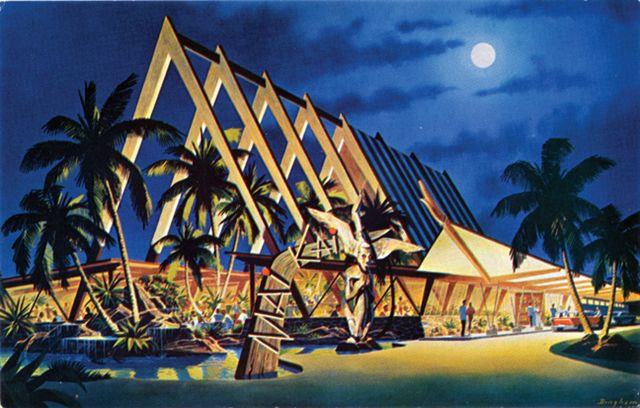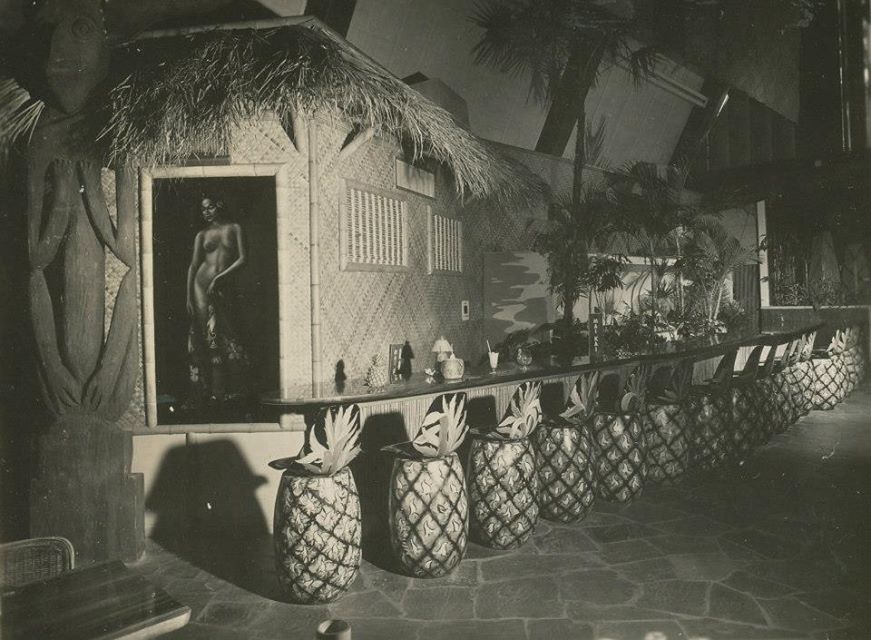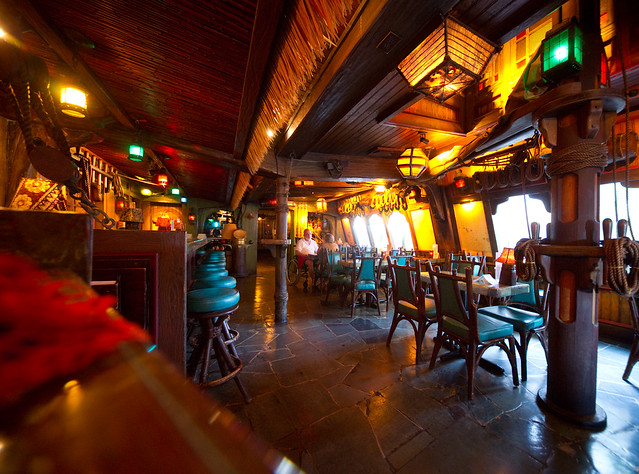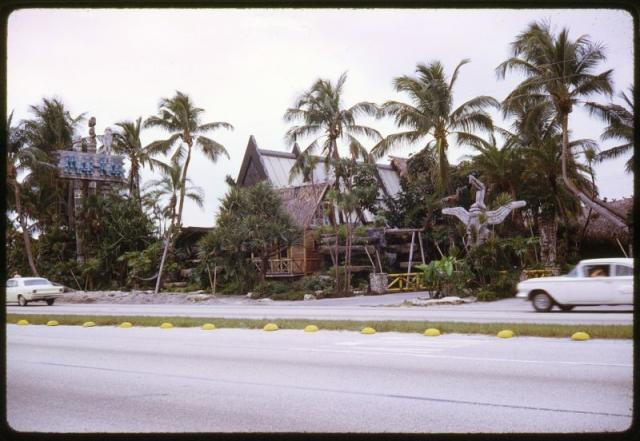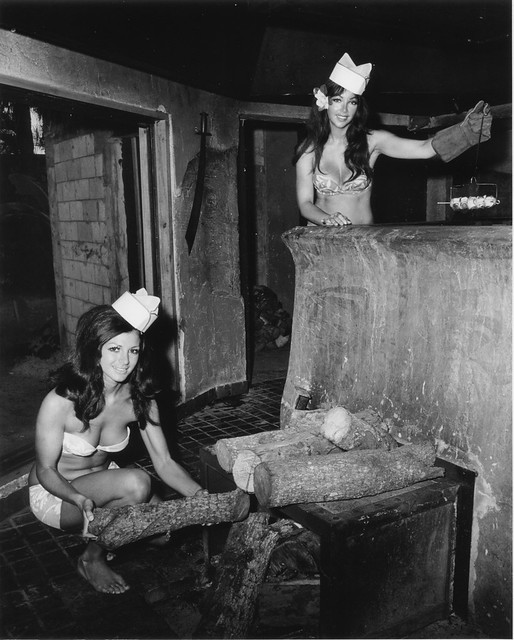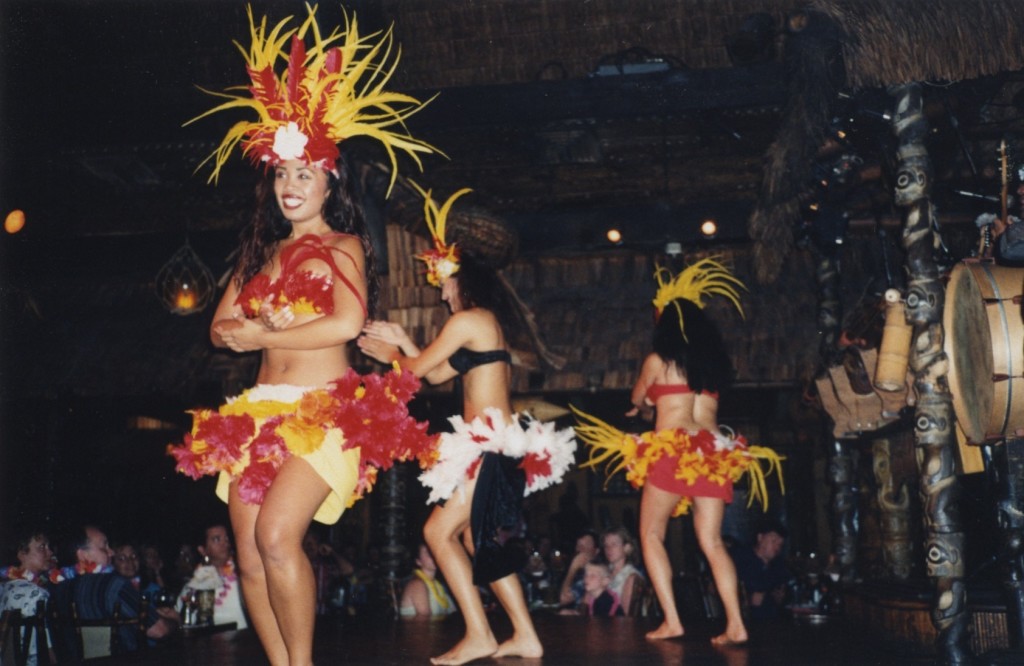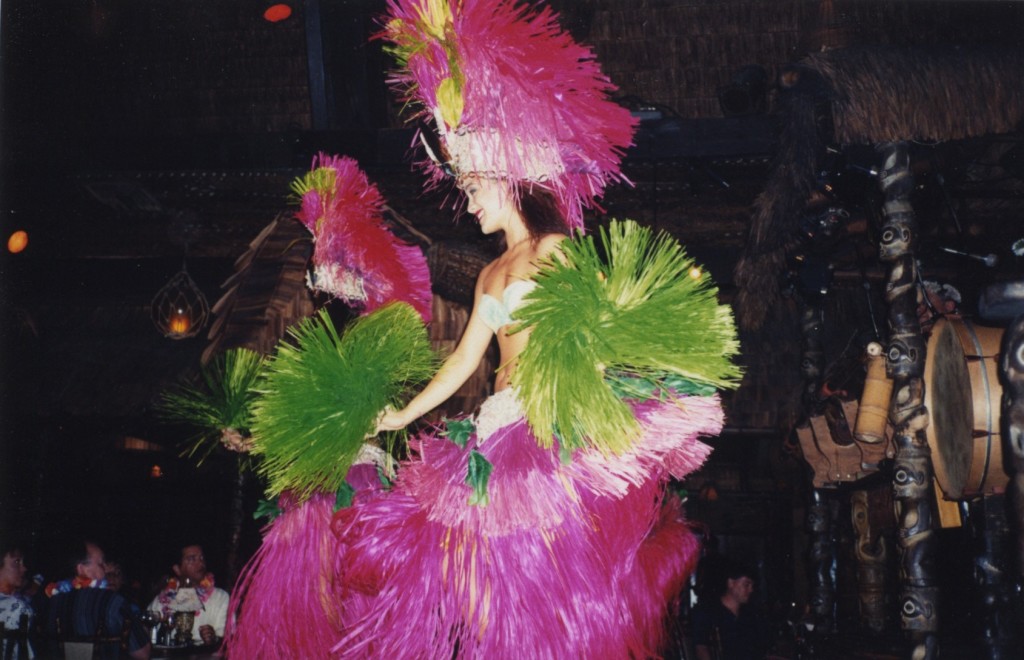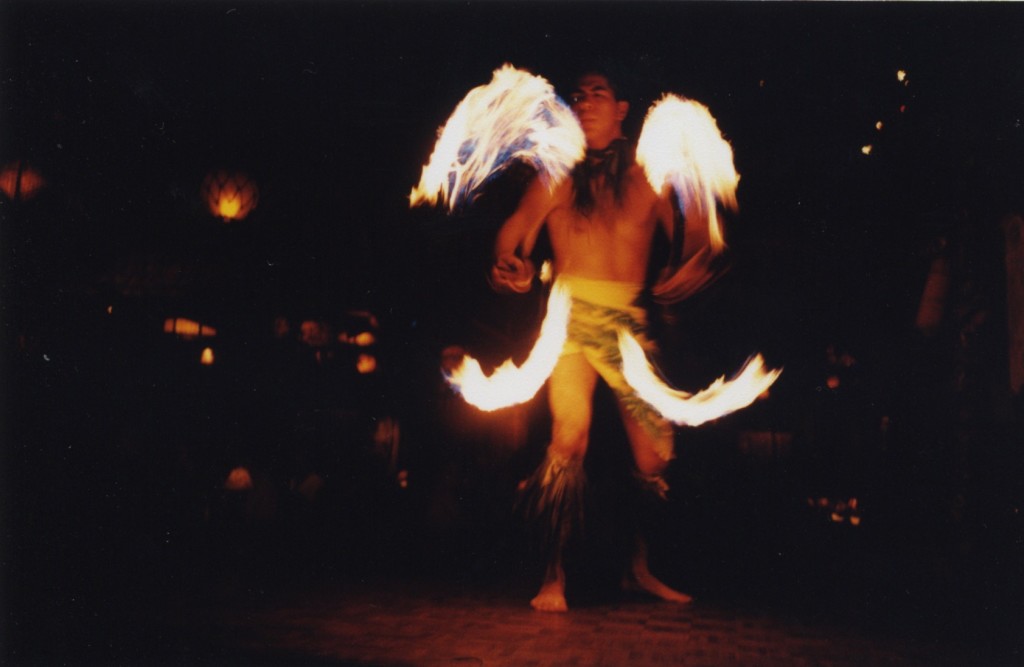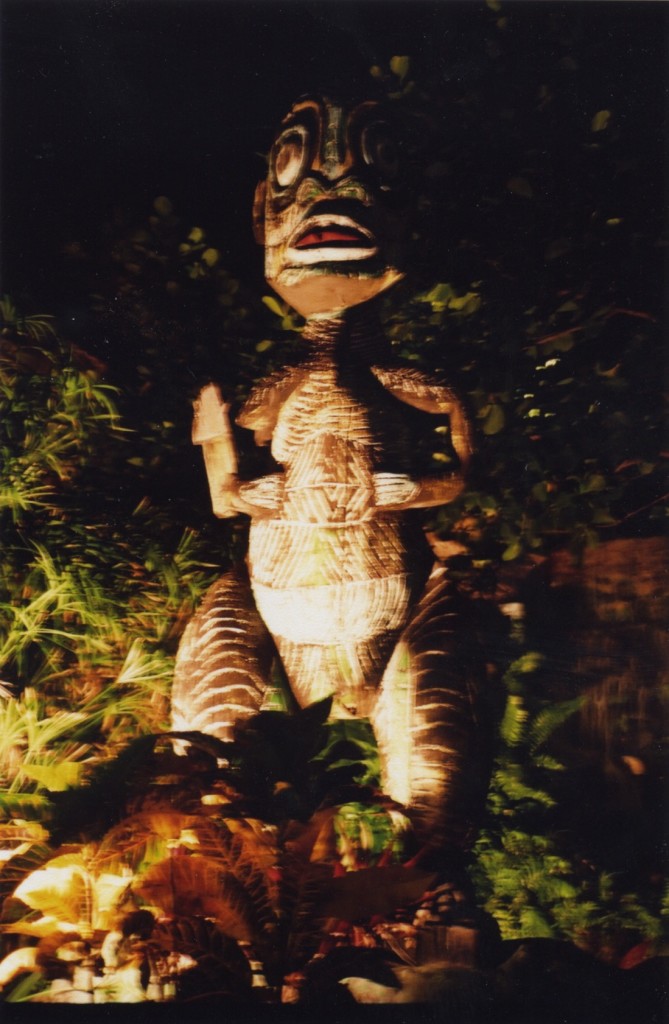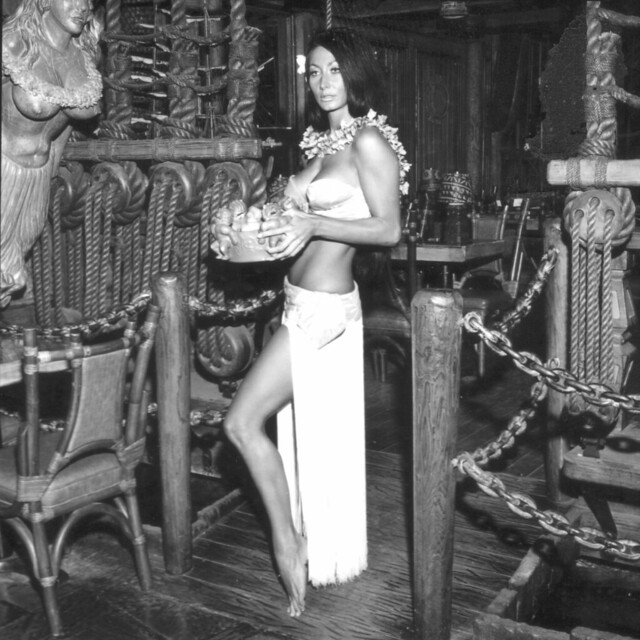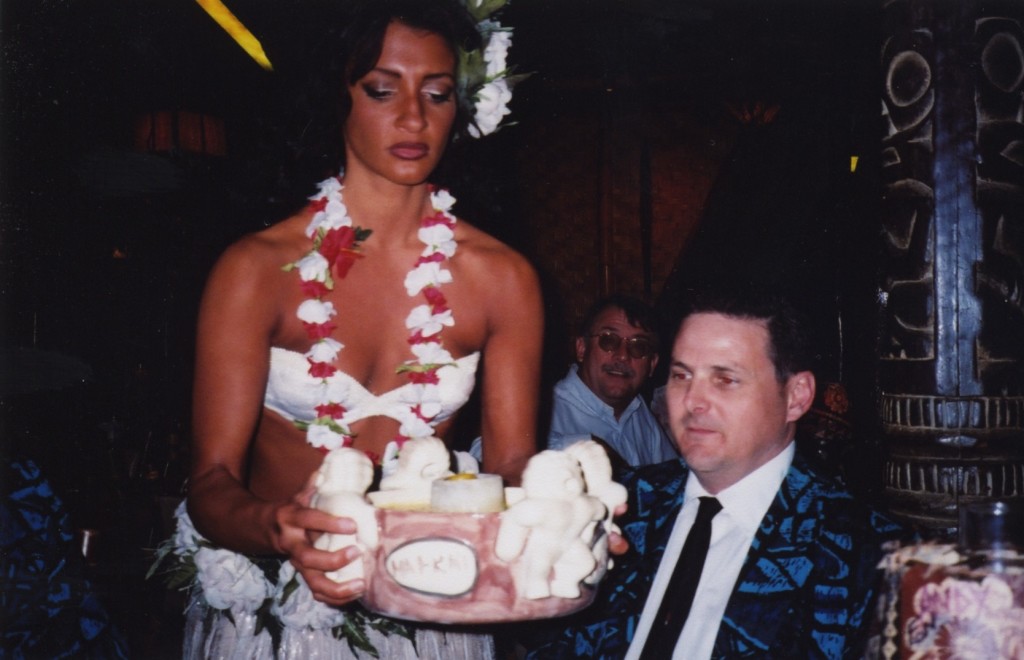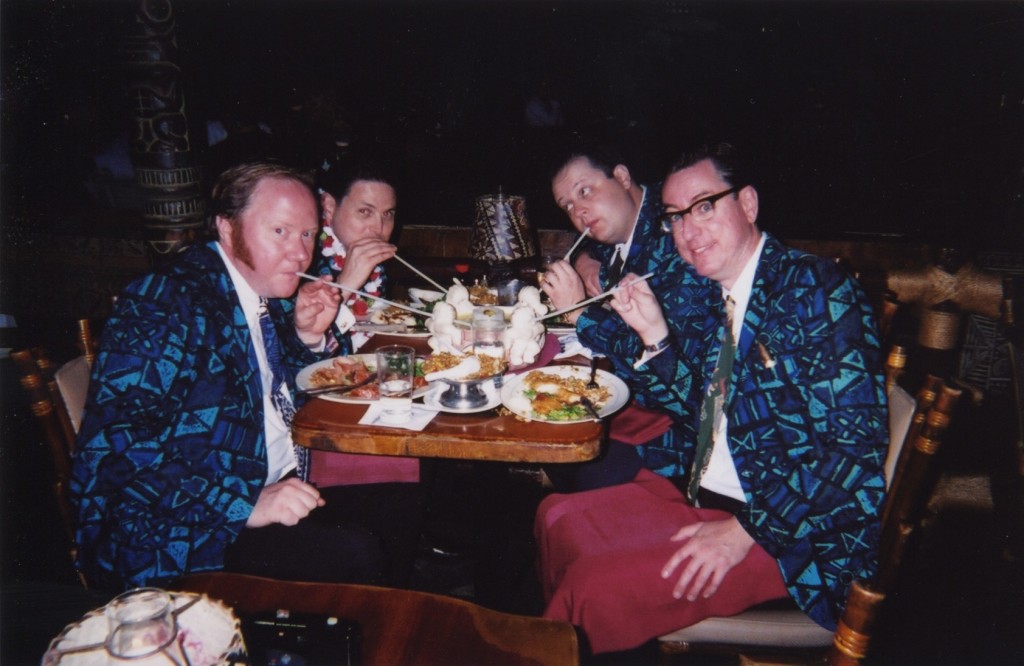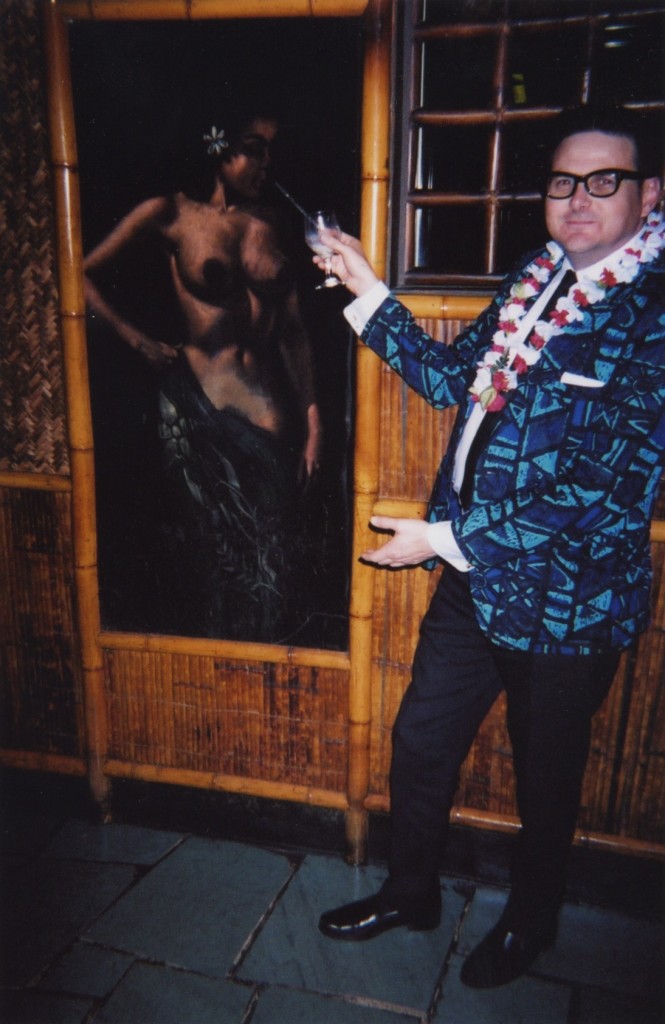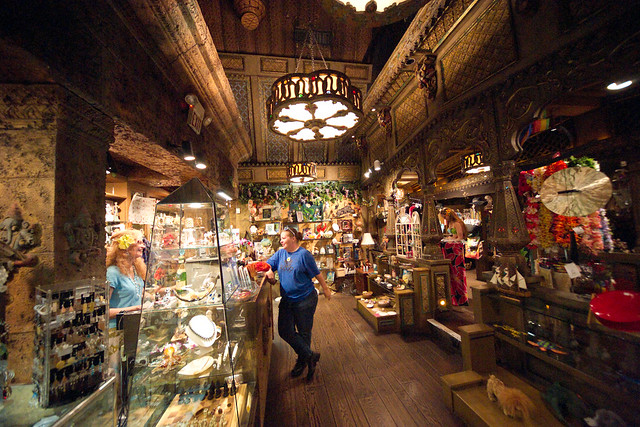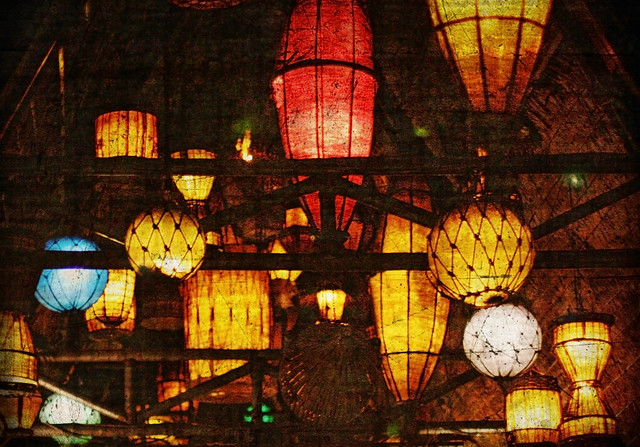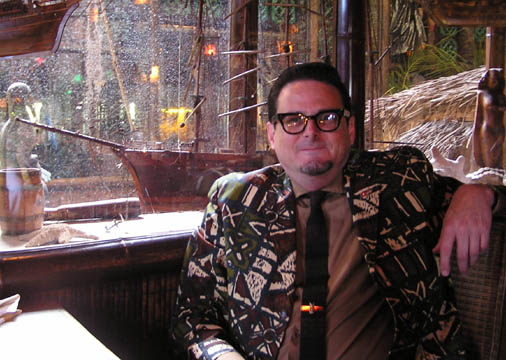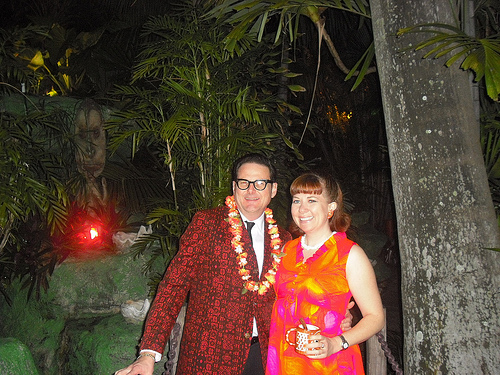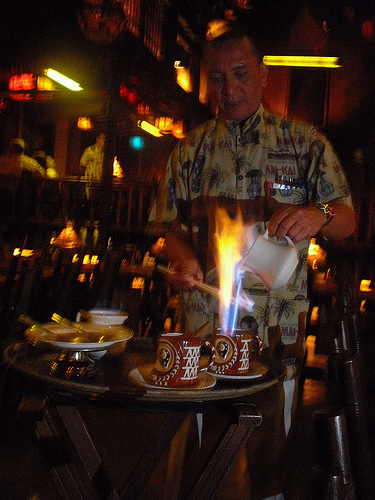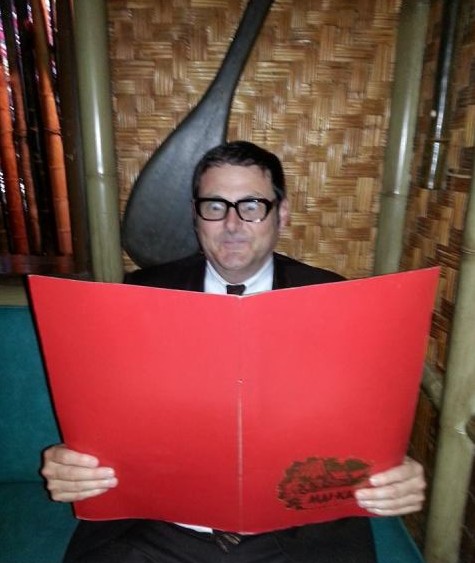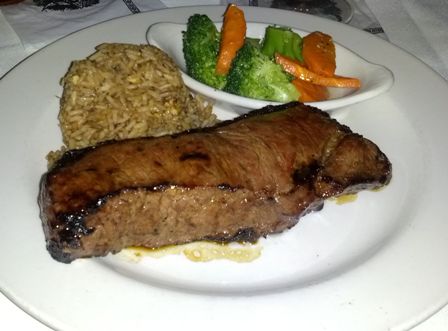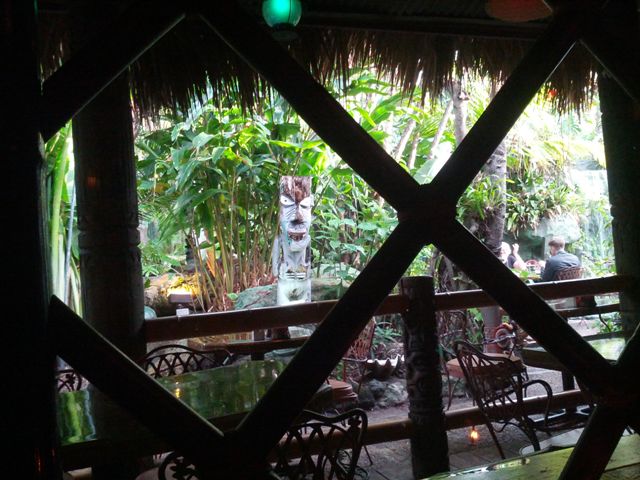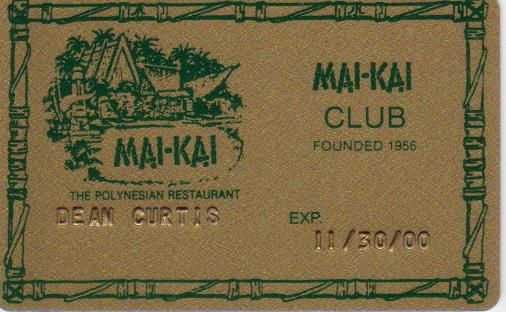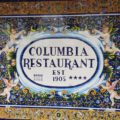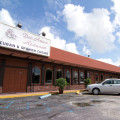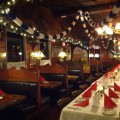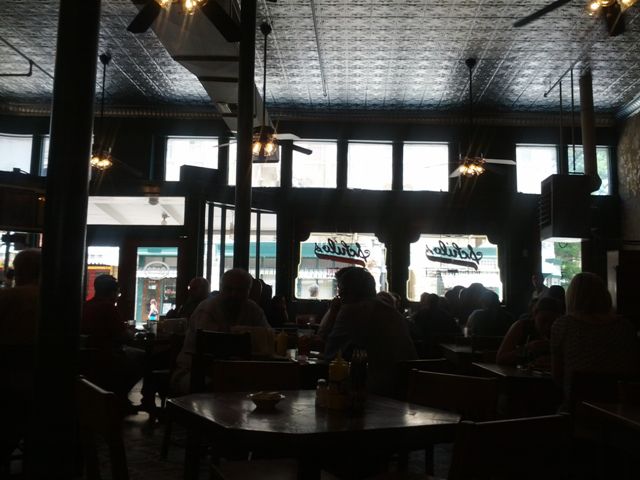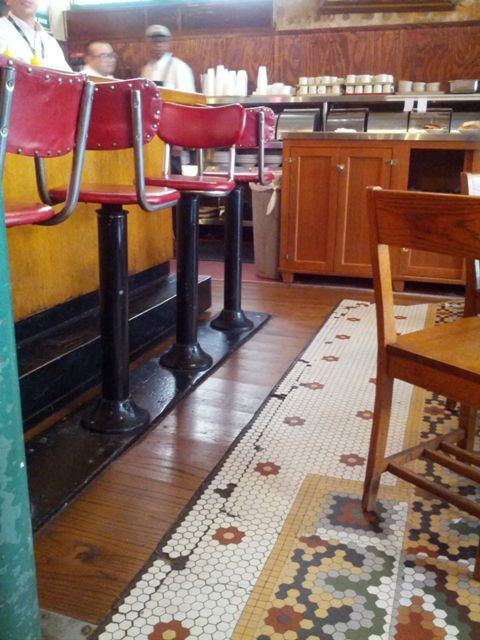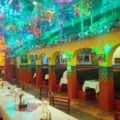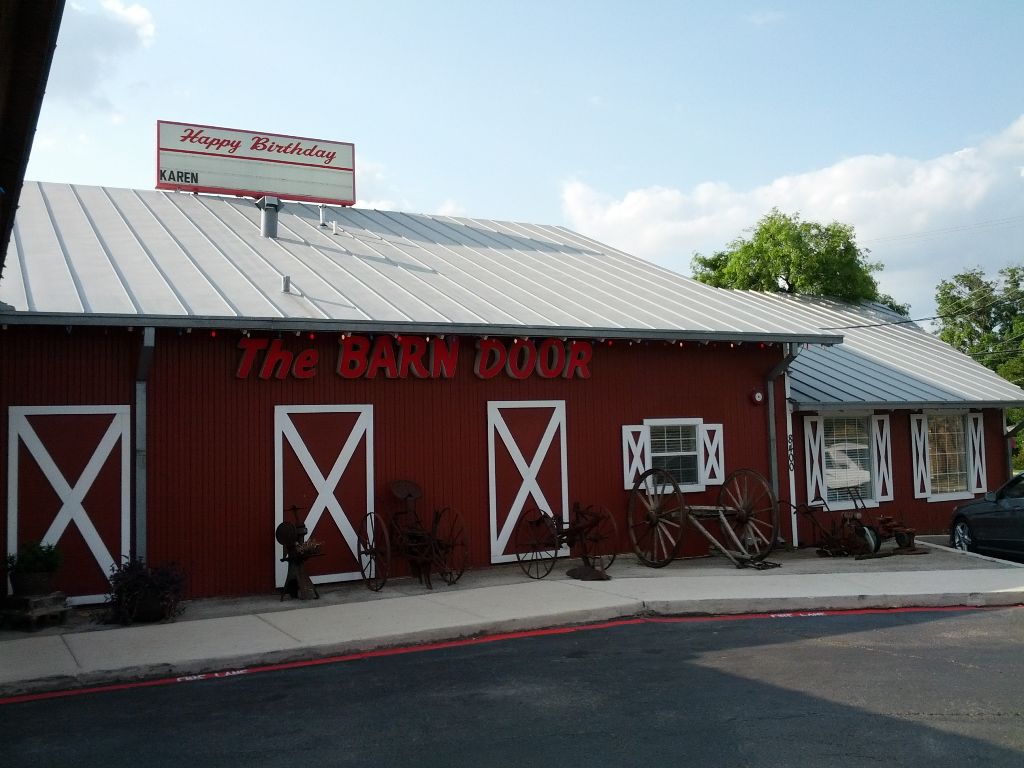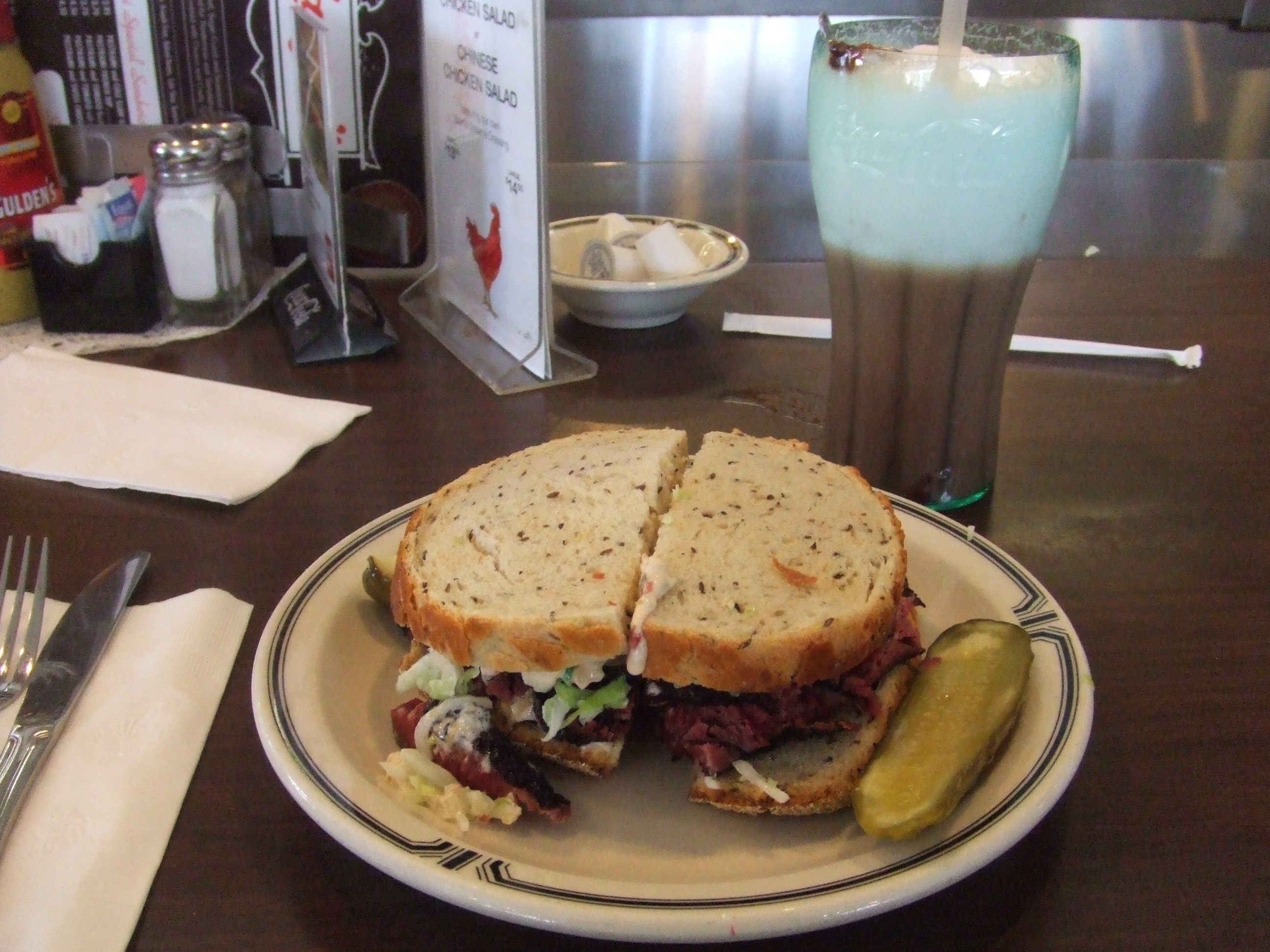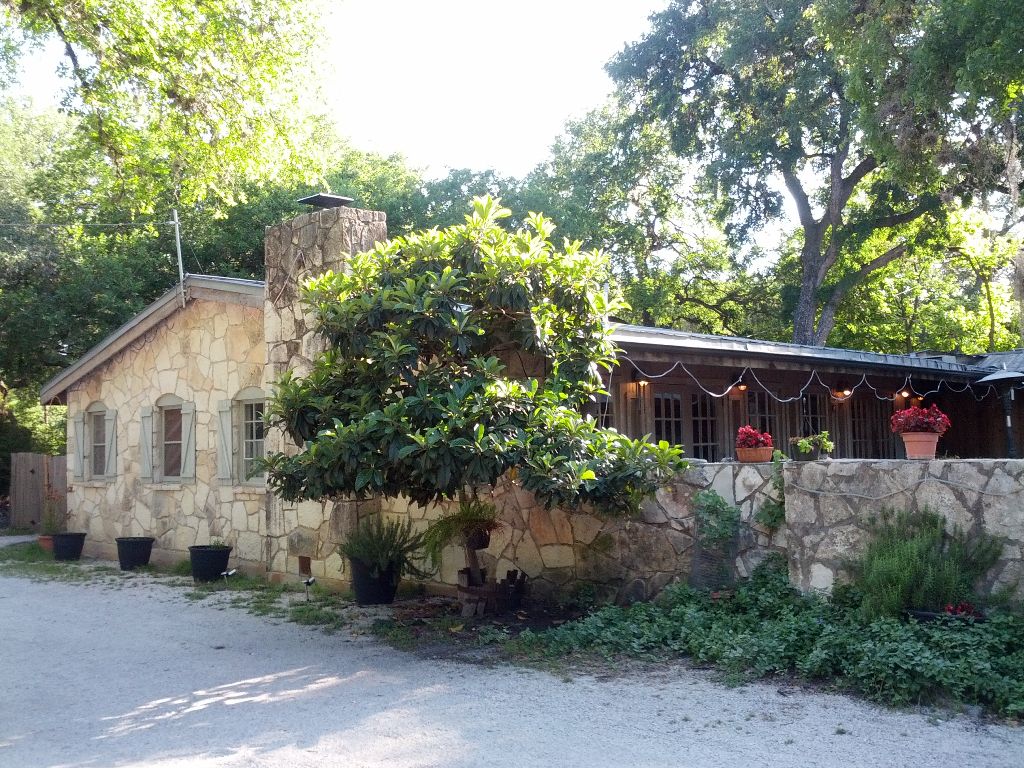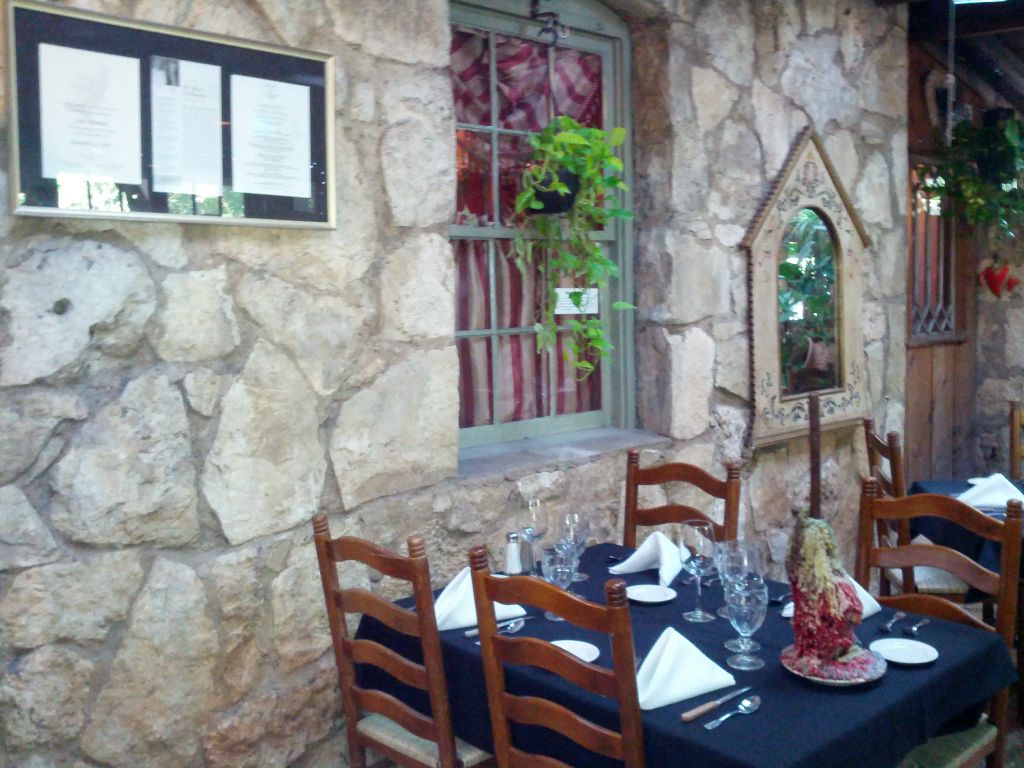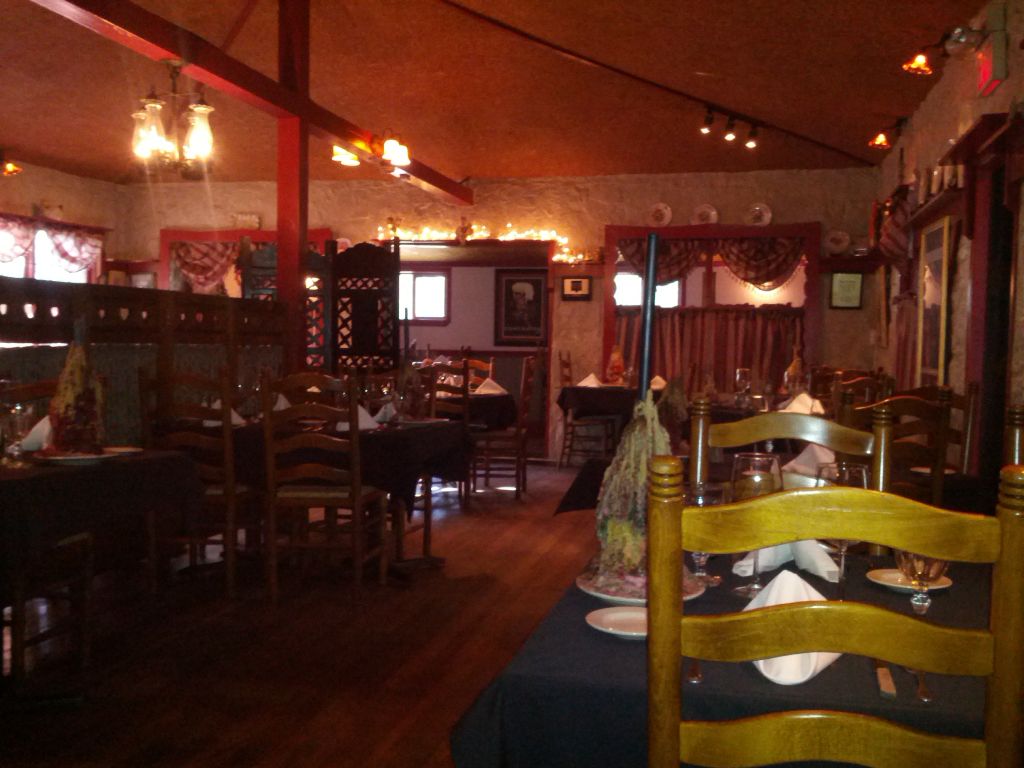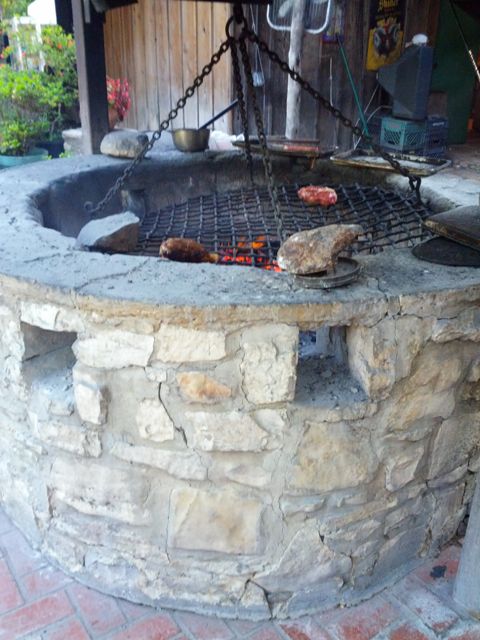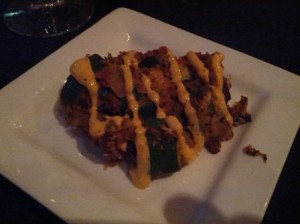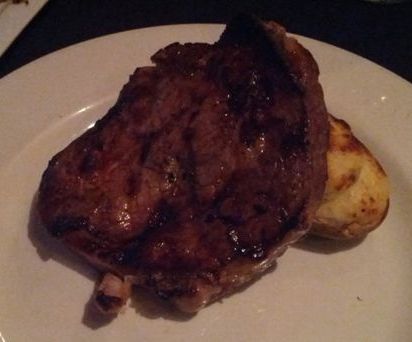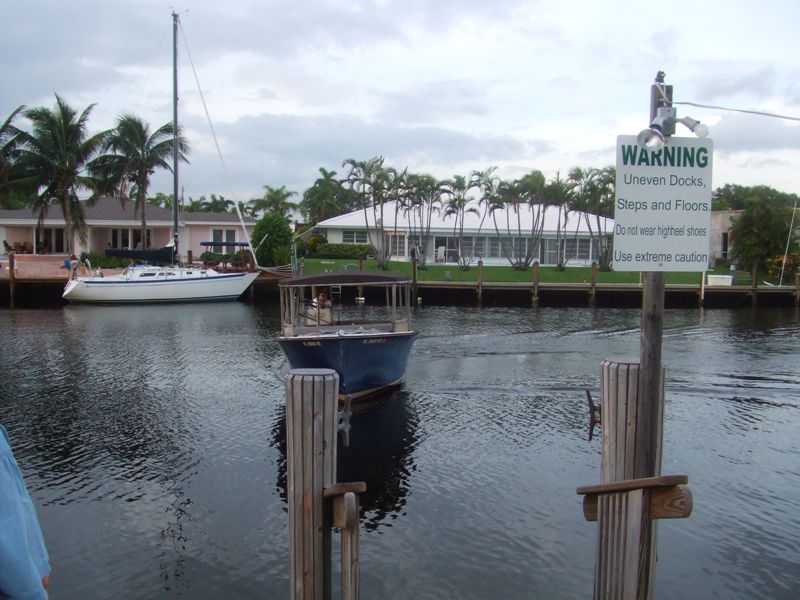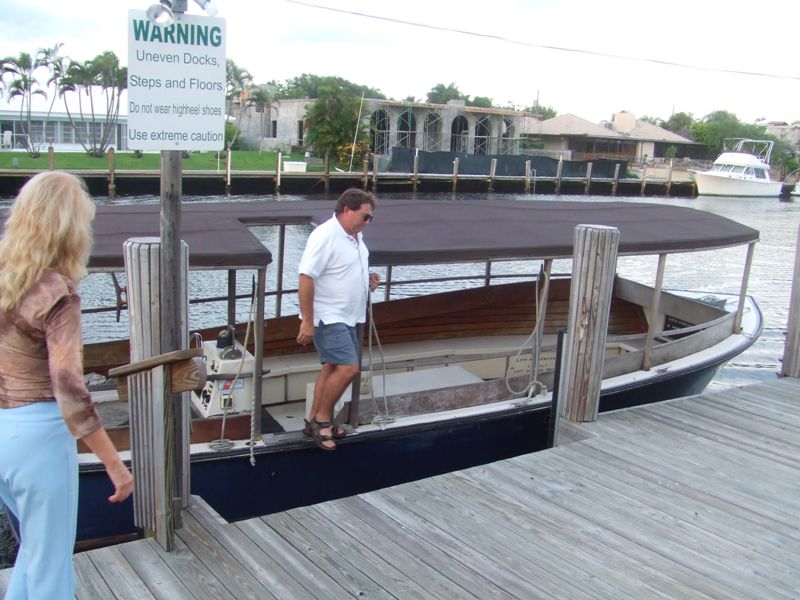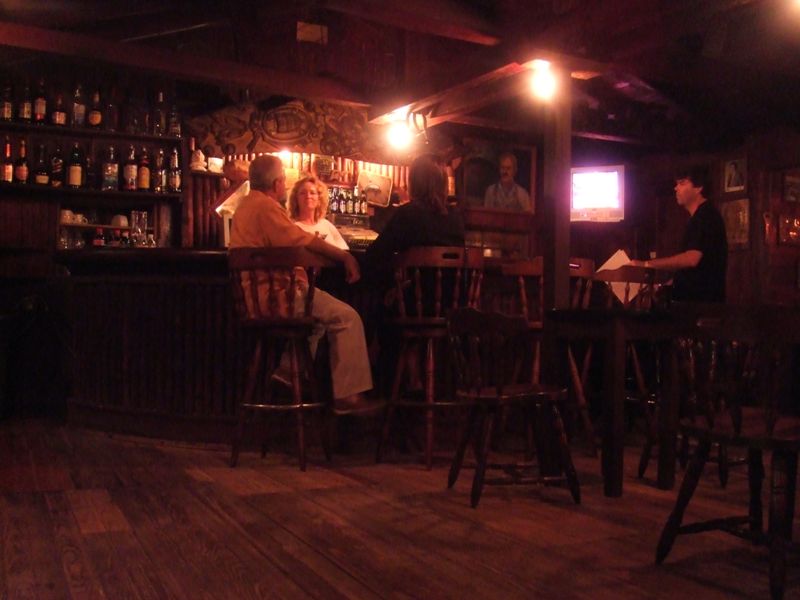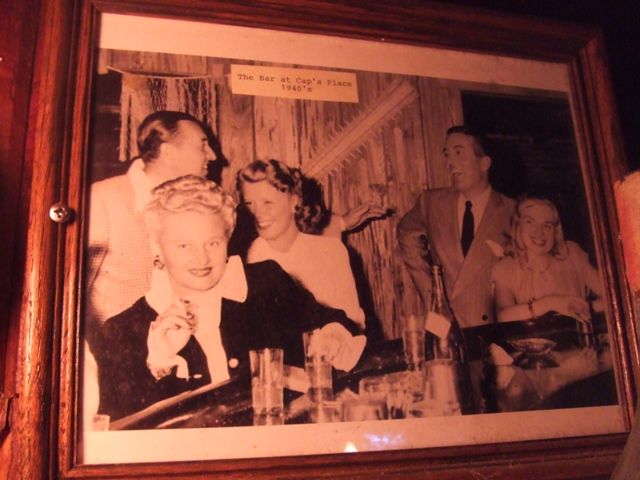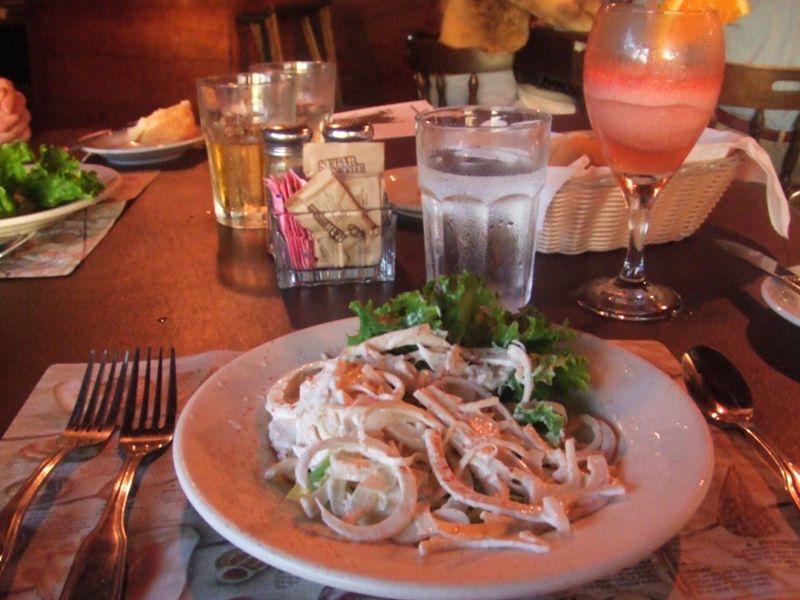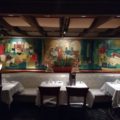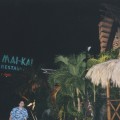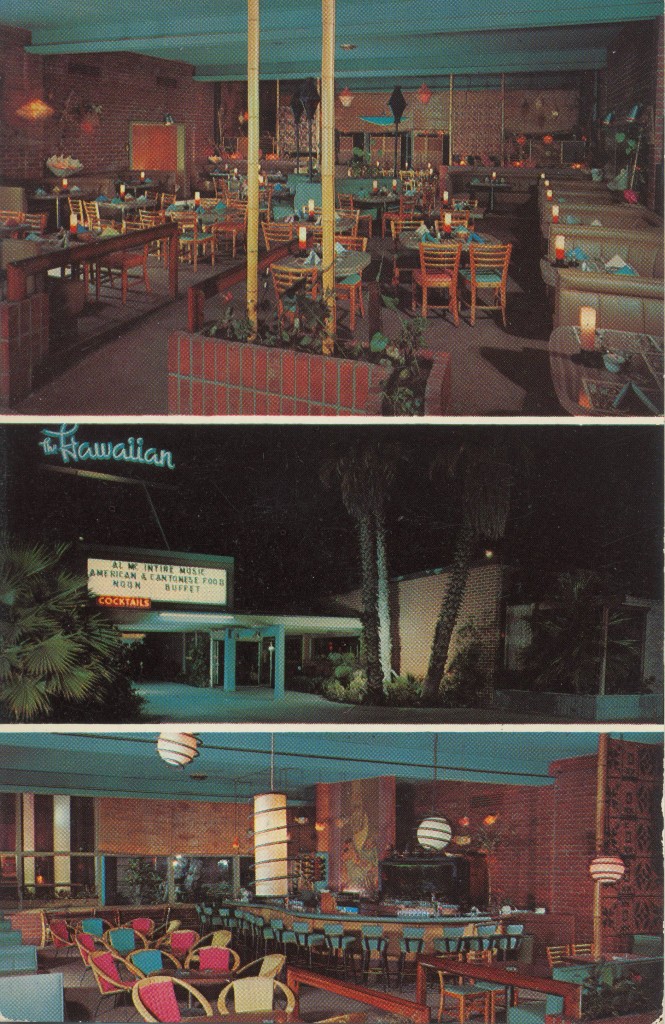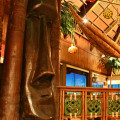I mentioned the Mai-Kai briefly in a earlier post on romantic restaurants for Valentine’s Day. The Mai-Kai has been celebrated online and in books. But since I recently returned from my seventh trip to Florida to visit the Mai-Kai (and my third Hukilau tiki event in Fort Lauderdale), here I would like to offer my personal story about the Mai-Kai, and try to explain why it is my favorite restaurant in the world so that I may inspire people to visit (or revisit) the fabulous Mai-Kai.
I suggest you make a cool tropical drink before we start and come back and start this live Martin Denny track:
My story with the Mai-Kai starts in the year 2000, when I was a member of the Society for Commercial Archeology (SCA), an avid reader of Otto Von Stroheim’s Tiki News (defunct), Jeff ‘Beachbum’ Berry’s Grog Log, a lurker on pioneer web sites about tiki like James Teitelbaum’s Tiki Bar Review Pages (which evolved into the Tiki Road Trip book), and a fan of Trader Vic’s in Emeryville and the Tonga Room in San Francisco. I was discussing with my girlfriend Robin what would be the Holy Grail of Tiki in the U.S. We narrowed our research down to two places: The Kahiki in Columbus, Ohio, which opened in 1961 and had recently been listed on the National Register of Historic Sites (the newest restaurant to be listed at the time), and the Mai-Kai in Fort Lauderdale, which opened in 1956. We picked the Mai-Kai as our Holy Grail for several reasons: because of the descriptions we read online by James Teitelbaum and in the Grog Log, where Jeff Berry wrote “Still going strong, the Mai Kai is the most perfectly preserved and beautifully appointed Polynesian palace left in America”, because we decided we would rather go to Florida than Ohio (duh!), because the drinks sounded better at the Mai-Kai, and because since the Kahiki was “listed” it was well protected, unlike the Mai-Kai, which could close at any time. How wrong we were about the Kahiki, which was demolished for a Walgreen’s later in 2000! But that’s a sad story that I don’t want to get into because this is a happy story about a fabulous Polynesian supper club that endures and thrives!
We arrived in Fort Lauderdale on a night in May of 2000, had dinner at the Caves Restaurant, which was cave themed with dinosaur sculptures in front and cave-like rooms for dining! Sadly, when I returned to Florida in 2002 the restaurant had burned down.
After our cave man and woman dinner of ribs, we drove along U.S. Highway 1 toward the Mai-Kai.
Before I continue my story, what follows is a not-so-brief history of the Mai-Kai (dates and numbers were gathered and double-checked on the web, mostly from Tiki Central, which often had conflicting info, so I used figures that reportedly came directly from the restaurant’s owners and staff if possible):
The Mai-Kai opened on December 28th, 1956, in the rural outskirts of Fort Lauderdale on U.S. Highway 1, the main north-south highway along the eastern seaboard. It was built for $350,000 by two brothers from Chicago, Bob and Jack Thornton, who were inspired by Don the Beachcomber, the Polynesian restaurant chain started in 1933 by the father of tiki bars and tropical drinks, Ernest Raymond Beaumont-Gantt (aka Donn Beach) with his small Hollywood bar Don the Beachcomber.
Founder of the Mai-Kai, Bob Thornton:
The Thornton’s partnered with Robert Van Dorpe, the manager of the Chicago Don the Beachcomber, and in so doing managed to obtain Donn Beach’s secret recipes for the chain’s famous tropical cocktails, along with snagging top staff from the Chicago restaurant, including bartender Mariano Licudine, chef Kenny Lee, and maître d’ Andy Tanato.
The original restaurant had an open air dining pavilion in front with an a-frame (that was completely covered later), as seen in this illustration by James Russell Bingham. Originally it was covered with a bug screen; then glass with windows that opened; later it had a permanent thatched roof.
In the 1960s a stage was added for the Polynesian Islander Review dinner show, which still has performances nightly (three shows on Saturday night). One of the original dancers, Mirielle Thornton from Tahiti, became choreographer of the show in 1963, married original owner Bob Thornton, and became owner of the Mai-Kai after Bob Thornton passed away in 1989 (Jack Thornton left the Mai-Kai in 1970 after having a stroke). Mirielle is still choreographer of the show, which changes every year. Today she runs the Mai-Kai with her son Dave Levy and daughter Kulani Thornton Gelardi.
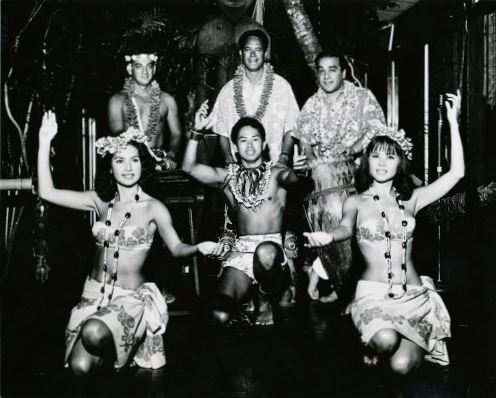
Islander Review show in 1963. Front L-R: Mireille, Kauwana and Faalia, back L-R: Toti, Kalani and Lundy. Image by the Mai-Kai’s Facebook page.
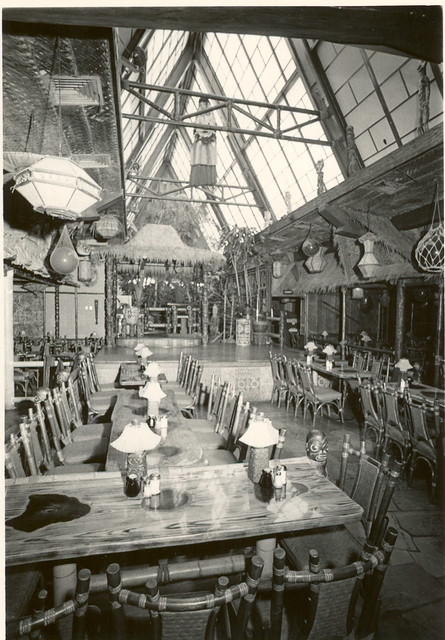
Main dining hall in front of the stage aka the “Garden Room”, with an atrium garden dining area behind the stage. Image by Chip and Andy, on Flickr.com.
In the 1960s and early 1970s the Mai-Kai was greatly expanded, adding more dining rooms, each named after a Polynesian island: New Guinea, Hawaii, Moorea (all three are on the lower level of the main showroom, along with the original garden room); Tonga (upper level of showroom), Bangkok (now the gift shop); Tahiti, Samoa, and Bora-Bora. All of these rooms are still in use except the Bora Bora room, which is a banquet room for private events. The gardens were also enlarged. The chief architect for the expansions was George Nakashima, working from plans by Bob and Jack Thornton.
The original 1956 Surfboard Bar seen here…
…was converted into the upper level Tonga dining room behind the main dining (garden) room, and the magnificent Molokai Bar was opened near the entrance, which survives to this day. Being inside the bar is like being inside an old ship, with rigging, masts, and windows that seem to have rain cascading down them. Beyond the windows are gardens with tikis, tropical plants, water features, and tiki torches, and hanging all over the ceiling are old rafia-wrapped jugs, lamps of all kinds, illuminated puffer fish, and other traditional tiki bar decor. I love the polished flagstone floor (throughout the entire restaurant), which from old photos seems to date back to the opening, and must have cost a fortune. There is a long wooden bar with cigar boxes, ship models and other nautical items displayed behind it but no bartenders to be seen. Instead, the cocktails and food are brought to you by lovely waitresses wearing Hawaiian outfits. The bartenders, like chefs in a kitchen, stay behind the scenes with their secret recipes and techniques, adding to the mystery and appeal of the bar.
Here is how the Mai-Kai looked in 1969 after a wooden entry bridge and porte-cochère were added. The small hut in front (demolished by a hurricane in 2005) and the Bora Bora room across the driveway from the entrance were also added in the 1960s.
Two Chinese wood-burning ovens for cooking meats and poultry were added in the 1970s.
Now that I’ve covered the history, back to my story of my first visit to the Mai-Kai. We drove along Highway 1 after dark, and approaching the Mai-Kai we started to see a glimpse of the huge sign and finally we arrived at the Mai-Kai and we couldn’t believe our eyes! Words could never do justice to the feeling you have when you first see the buildings surrounded by tropical plants, tikis, and flaming tiki torches, and hear the rushing waterfalls in front (I still get excited every time I approach it).
We drove our car across the wooden entry bridge to the valet stand, and entered the most wonderful Polynesian palace in the world. I immediately felt somewhat under dressed, even in an aloha shirt and slacks. This was like going back in time 40 years when people always dressed up to go out; I felt like I should have done so also to complete the time travel experience. We had drinks in the Molokai Bar that first night, and what great drinks they were! I had made the drinks in the Grog Log before but never in my life had I tasted such delicious (and strong!) tropical cocktails up to that time. These were even better than the drinks at the Tiki Ti in Los Angeles (which are pretty darn good) or my local Trader Vic’s.
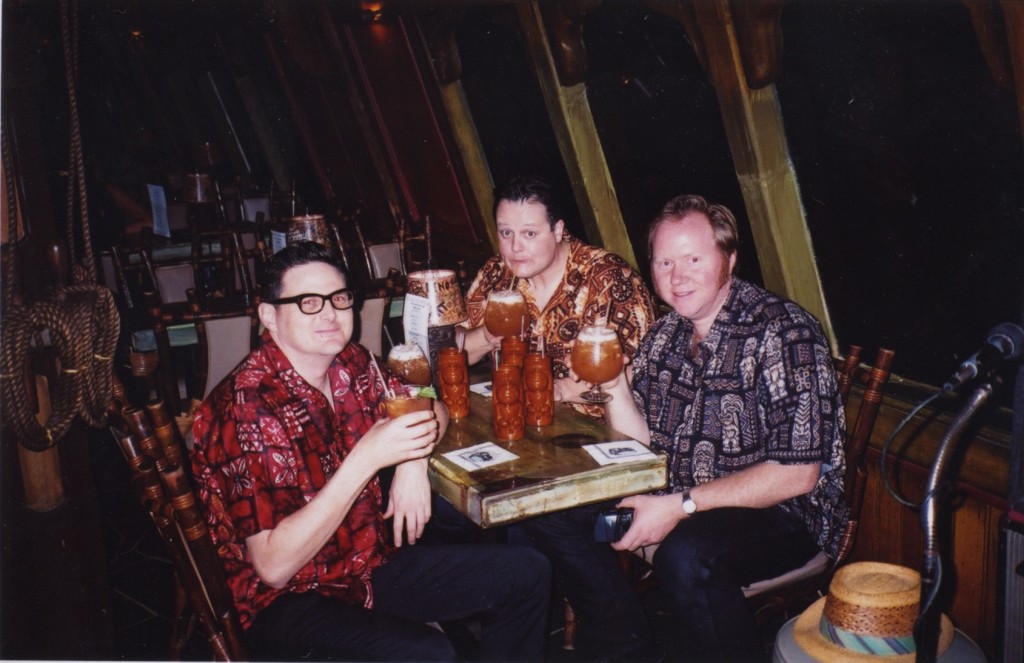
Enjoying tropical cocktails in the Molokai bar with my buddies Jeff and Bruce on my next visit in 2002
The cocktail menu is extensive, with sections for mild, medium, and strong drinks. All of the juices are fresh squeezed, and the rum is high quality (some drinks mention the use of Appleton, and some use Lemon Hart Demerara). I won’t go into the cocktails in much detail here because they have been covered extensively online before (see further reading at the end of this post). Some of my favorites are the Barrel O’ Rum, Jet Pilot, Shark Bite, S.O.S., Deep-Sea Diver, Mutiny, Special Planters Punch, Yeoman’s Grog, and Cobra Kiss. As many of the cocktails came from the old Don the Beachcomber recipes their names are variations from their original names (Yeoman’s Grog is a Navy Grog, for example).
A couple of days later, on a Saturday night, Robin and I headed for the Mai-Kai again for dinner and the Polynesian Islander Review. What an amazing classic Polynesian supper club experience, unequaled anywhere in the continental U.S! We were seated at a table right next to the stage so we had the perfect view of the dancers’ colorful outfits as they performed dances from different Polynesian islands (in different costumes for each dance) to music by a live band.
The finale was the Samoan fire dance! It got pretty darn hot so close to the stage!
After dinner a flaming drink is a must!…
…followed by a stroll through the gardens.
At this point I feel I should mention the level of service at the Mai-Kai. I have been when it was fairly slow and when it was packed with Hukilau revelers and in all visits the service was always very friendly, courteous, and attentive. When you first step in the door the captain or maître d’ always greets you graciously. The top staff all wear jackets, while the waiters in the restaurant wear special Mai-Kai aloha shirts with slacks, and the cocktail waitresses in the Molokai bar wear Hawaiian print two-piece outfits (mini-sarong and top).
In 2002 I returned to the Mai-Kai with three friends on a road trip through South Florida. We all wore matching Sandwich Isles jackets from the 1960s for the big night of dinner, drinks, and the show. We ordered a Mystery Bowl, which is served by the Mystery Girl in a secret ritual which I cannot divulge (so you will have to experience it yourself).
The Mai-Kai has many rare authentic Polynesian artifacts and artworks throughout the restaurant, even after much of the collection was donated to Stanford in the 70s because the restaurant became uninsurable. Be sure and have a stroll though the restaurant and gardens when you visit, looking into the display cases in the Samoan and Tahitian rooms. Here I am with a rare original black velvet painting by Leeteg of Tahiti:
When you visit don’t forget to check out the gift shop. Even if you don’t find anything to buy the room is spectacular (always look up when at the Mai-Kai!). The room was the Bangkok dining room before the gift shop moved there from the Bora Bora room.
Speaking of looking up, check out the lamps above the main dining room in front of the stage as you walk around, or when you are waiting for the show.
In 2005 and 2006 I returned to the Mai-Kai during the Hukilau event. In the fall of 2005 hurricane Wilma did extensive damage to the outside of the Mai-Kai, but the inside weathered the storm. It was closed for about a week for repairs. Hukilau 2006 was an especially good event because it happened during the year that the Mai-Kai turned 50. There were special photo exhibits and presentations of the Mai-Kai’s history and the turnout was great.
In late 2008 the Mai-Kai closed for much needed repairs and renovations since recent hurricanes had done some damage. Many new plants were added to the gardens, the porte-cochère was rebuilt and re-thatched, and the Molokai bar was repaired to fix some leaks. In January of 2009 I went with my girlfriend Carrie to celebrate my birthday, and on the same day they had replaced 600 worn rattan chairs with a truckload of new ones.
You may be wondering about the food by now. The menu is mostly Cantonese and classic Polynesian restaurant dishes. I find that you can’t go wrong ordering seafood most anywhere in Florida and the Mai-Kai is no exception. Try the shrimp appetizers and the local fish that is on the menu.
But my favorite dishes are the meats cooked in the Chinese oven, such as pork tenderloin, ribs, rack of lamb, or a steak, like this New York strip, which I had on my recent visit. It was tender (aged), juicy, and had a great slightly smoky flavor from the oven.
I feel like I could go on and on about the Mai-Kai but I have to end this post sometime. So, let me end by saying that personally I feel that until I went to the Mai-Kai I had not fully experienced Polynesian / Tiki escapism that was so popular in the 1950s through the 1960s. Sure, I had been to the Tonga Room, which is a great, unique place, but always somewhat lacking (in the drinks, the food, and especially the entertainment). My local Trader Vic’s had better food and drinks, and proper music, so it was the closest I came to the real thing. But neither compares to the one and only (and almost completely intact) Mai-Kai for true time-travel back to the heyday of the Polynesian Pop experience. You could make a good tropical drink in a tiki mug at home, put on a Martin Denny album, and it is quite nice. But something is missing. The atmosphere, the soft Hawaiian music, the “rain” on the windows, the best cocktail served by a friendly, smiling Molokai maiden, and you are back in time to the original Tiki era. Luckily, there are a few other places that have excellent tropical cocktails in beautiful classic tiki bar surroundings, but for the whole shebang with dinner and a show nothing beats the Mai-Kai.
A suggestion: The Hukilau is a blast, but it can get pretty crowded at the Mai-Kai during the event. So, I recommend that you go your first time to the Mai-Kai on a “normal” night (even the Wednesday before the Hukilau starts) for cocktails, dinner, and the show, so you can experience it on a regular night as people have done for over 56 years. It is such a romantic place so make a date with your best gal or guy!
There are some deals you should take advantage of at the Mai-Kai. First, they have happy hour from opening until 7PM nightly (except Monday) with 50% off drinks (with a few exceptions) and appetizers!
Every night they are open they have two cocktails at half-price from 7PM until closing.
On Wednesday nights they have a free buffet from 5-9PM if you spend $10 on drinks in the bar.
They also have special prix fixe menus (check web site for details).
Every night except certain holidays in the non-show dining rooms (Tahiti, Samoa, gardens) you get one entree (off equal or lesser value) free when you buy one (when you make a reservation ask for the BOGO deal). Here is the view of the garden from my table in the Tahitian Room at the recent Hukilau:
Finally, they have a Mai-Kai Club, which is free to join, that gets you 25% off from May-Nov on Sundays-Thursdays. If you spend $500 in the club by August 29th you get 50% off those days through November! You also get some drink and show coupons and this classy card – impress your friends!
Here’s a clip of the wonderful new Swedish band Ìxtahuele performing in the Tahiti Room during Hukilau 2013 at the Mai-Kai. Their new album is highly recommended for your next tiki party! It’s on a limited edition LP, CD, and in iTunes.
Further reading:
Jeff ‘Beachbum’ Berry’s book Sippin Safari has a chapter on the Mai-Kai’s original mixologist Mariano Licudine.
Tim “Swanky” Glazner is a web pioneer who had his SwankPad.org site up in the pre-commercialization-of-the-web mid-1990s. He has collected Mai-Kai items for years and researched the Mai-Kai extensively. He was co-creator of the Hukilau event in 2002 in Atlanta, which moved to Fort Lauderdale and the Mai-Kai in 2003. In 2012 he presented a complete history of the Mai-Kai at Hukilau. Check out his site’s collections of Mai-Kai postcards and calendars, as well as other eye candy.
Peter Moruzzi’s excellent new book Classic Dining: Discovering America’s Finest Mid-Century Restaurants has a chapter on the Mai-Kai with beautiful photos by Sven Kirsten (and a cover inspired by the Mai-Kai).
Tiki Central has Mai-Kai info and photos spread all over the place, but there are some especially rich topics on its history here:
Mai Kai 50th Anniv. – a look back in pictures!
Mai Kai, Fort Lauderdale
The Book of Tiki (first published in September, 2000, and currently out of print) by Sven Kirsten has a four page spread on the Mai-Kai.
The Atomic Grog site has an excellent guide to all the Mai-Kai’s cocktails.
Last but definitely not least is Humuhumu’s informative guide to tiki bars all over the world, Critiki, and its page on the Mai-Kai.
Mai-Kai
3599 N Federal Hwy, Fort Lauderdale, FL 33308
(954) 563-3272
Open Tues-Fri 5pm-close, Sat 4:30pm-close, Sun 4pm-close (closing varies but is about 11pm on weekdays and about 1am on Fri & Sat).
Dinner served until 8:30pm on Tue-Thu, until 10pm on Fri, until 11:30pm on Sat, and until 9pm on Sun
Showtimes (after dinner is served): Tue-Thu: 8pm., Fri: 7.30pm and 9.45pm, Sat: 6:30pm, 9:30pm and 11pm, Sun: 6pm and 8.30pm. The show charge is $10.95 per person.
Dress code (I wish more restaurants had one): No hats, t-shirts, tank tops, beach shorts or flip flops allowed.

